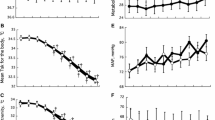Abstract
The effects of the cold pressor test on the coronary circulation have been clearly defined but the effects on the peripheral vasculature are less well understood. To measure the peripheral vasomotor response during cold pressor test perfusion in the upper extremity contralateral to the cold immersion was assessed by laser Doppler flowmetry and skin-surface temperature gradients. To identify the mechanism of vasoconstriction, cold pressor test was performed before and after the administration of phentolamine, an α-adrenoceptor antagonist. Vasoconstriction during cold pressor test was demonstrated by both skin-surface temperature gradients and by laser Doppler flowmetry. This vasoconstrictor response was significantly attenuated by the administration of phentolamine. The results demonstrate that the cold pressor test induces an α-adrenoceptor mediated vasoconstriction in the peripheral vasculature.
Similar content being viewed by others
References
Hines EA, Brown GE. The cold pressor test for measuring the reactibility of the blood pressure: data concerning 571 normal and hypertensive subjects.Am Heart J 1936;11: 1–9.
LeBlanc J, Dulac S, Cote J, Girard B. Autonomic nervous system and adaption to cold in man.J Appl Physiol 1975;39: 181–186.
Robertson D, Johnson GA, Robertson RM, Nies AS, Shand DG, Oates JA. Comparative assessment of stimuli that release neuronal and adrenomedullary catecholamines in man.Circulation 1979;59: 637–643.
Cummings MF, Steele PM, Mahar LJM, Frewin DB, Russell WJ. The role of adrenal medullary catecholamine release in the response to a cold pressor test.Cardiovasc Res 1983;17: 189–191.
McLean JK, Sathasivam P, MacNaughton K, Graham TE. Cardiovascular and norepinephrine responses of men and women to two cold pressor tests.Can J Physiol Pharmacol 1992;70: 36–42.
Winer N, Carter C. Effect of cold pressor stimulation of plasma norepinephrine, dopamine-beta-hydroxylase, and renin activity.Life Sciences 1977;20: 887–894.
Crea F, Davies G, Chierchia S, Romeo F, Bugiardini R, Kaski JC, Freedman B, Maseri A. Different susceptibility to myocardial ischemia provoked by hyperventilation and cold pressor test in exertional and variant angina pectoris.Am J Cardiol 1985;56: 18–22.
Nabel EG, Ganz P, Gordon JB, Alexander RW, Selwyn AP. Dilation of normal and constriction of atherosclerotic coronary arteries caused by the cold pressor test.Circulation 1988;77: 43–52.
Shea MJ, Deanfield JE, deLandsheere CM, Wilson RA, Kensett M, Selwyn AP. Asymptomatic myocardial ischemia following cold provocation.Am Heart J 1987;114: 469–476.
Mudge CH, Grossman W, Mills RM, Lesch M, Braunwald E. Reflex increase in coronary vascular resistance in patients with ischemic heart disease.N Engl J Med 1976;295: 1333–1337.
Rubinstein EH, Sessler DI. Skin-surface temperature gradients correlate with fingertip blood flow in humans.Anesthesiology 1990;73: 541–545.
McRaven DR, Mark AL, Abboud FM, Mayer HE. Responses of coronary vessels to adrenergic stimuli.J Clin Invest 1971;50: 773–778.
Vatner SF, Higgins CB, Braunwald E. Effects of norepinephrine on coronary circulation and left ventricular dynamics in the conscious dog.Circ Res 1974;34: 812–823.
Lopez M, Sessler DI, Walter K, Emerick T, Ozaki M. Rate and gender dependence of the sweating, vasoconstriction, and shivering thresholds in humans.Anesthesiclogy 1994;80: 780–788.
Rose G. Cold weather and ischaemic heart disease.Br J Prev Soc Med 966;20: 97–100.
Bainton D, Moore F, Sweetnam P. Temperature and deaths from ischemic heart disease.Br J Prev Soc Med 1977;31: 49–53.
Frank SM, Beattie C, Christopherson R, Norris EJ, Perler BA, Williams GM, Gottlieb SO. Unintentional hypothermia is associated with postoperative myocardial ischemia.Anesthesiology 1993;78: 468–476.
Kregel KC, Seals DR, Callister R. Sympathetic nervous system activity during skin cooling in humans: relationship to stimulus intensity and pain sensation.J Physiol 1992;454: 359–371.
Wolf S, Hardy JD. Studies on pain observation on pain due to local cooling and on factors involved in the ‘cold pressor’ effect.J Clin Invest 1941;20: 521–533.
Raja SN, Turnquist JL. Regulation of cutaneous blood flow in patients with neuropathic pain.7th World Congress on Pain 1993; abstract 348.
Author information
Authors and Affiliations
Rights and permissions
About this article
Cite this article
Frank, S.M., Raja, S.N. Reflex cutaneous vasoconstriction during cold pressor test is mediated through α-adrenoceptors. Clinical Autonomic Research 4, 257–261 (1994). https://doi.org/10.1007/BF01827431
Received:
Revised:
Accepted:
Issue Date:
DOI: https://doi.org/10.1007/BF01827431




